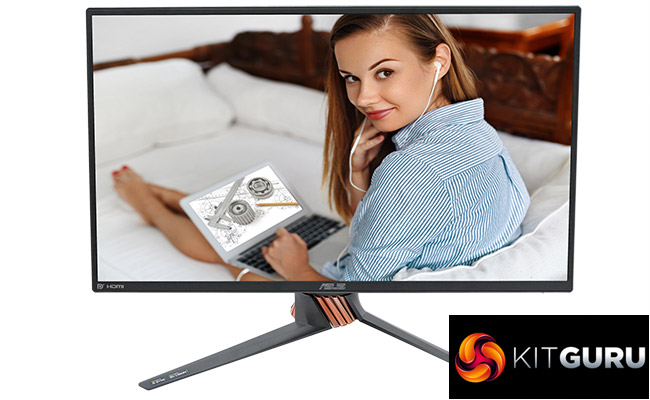
Gaming monitors are clearly going through a bit of a growth spurt, and ASUS is a company particularly focusing on this area. The ROG SWIFT PG258Q is a 24.5in screen with a whopping 240Hz top refresh and NVIDIA G-Sync, plus a host of other features specifically tailored for serious gamers.
The PG258Q takes the normal route for gaming screens of using a TN panel as its basis. This may not be the best technology for image quality, but it does mean that response is kept down to 1ms grey-to-grey, which many gamers will favour over pure colour fidelity. There are plenty of other gamer-focused features on offer too, with GamePlus modes available in the menu and game-oriented configuration presets.
The general specification is a little above the norm, too. The stated contrast of 1,000:1 is as expected for TN, but there’s plenty of brightness available, with a 400cd/m2 rating. However, although a USB 3.0 hub is built in, this only provides two downstream ports, which is strange when no webcam or memory card reader is provided to purloin the other two we would expect.
The video ports on offer are also fairly minimal, with just one each of DisplayPort and HDMI, and no DVI. The lack of VGA is less of a worry. There is a headphone jack for feeding out analog audio coming in via HDMI or DisplayPort. But there’s no routing of your analog audio connections to a more convenient place on the monitor’s body.
Although TN is usually associated with more keenly priced screens, the ASUS ROG SWIFT PG258Q most definitely doesn’t fit into that category. However, whilst the ability to provide 240Hz refresh and NVIDIA G-Sync have pushed the cost up to a pretty astronomical £559.99, they are the current state of the art, even if this price may well fall as more vendors provide the screen. Let’s find out if the PG258Q is worthy of its premium in other areas.
Specification:
Screen size: 24.5-inch, 16:9 aspect
Native resolution: 1,920 x 1,080
Refresh rate: 240Hz
Panel type: TN
Contrast ratio: 1000:1 (typical)
Brightness: 400cd/m2
Response time: 1ms Grey-to-Grey
Display inputs: HDMI, DisplayPort
USB hub: Yes
Tilt: Yes
Raise: Yes
Swivel: Yes
Other: Headphone jack
Retail Price: £559.99 (inc. VAT)
 KitGuru KitGuru.net – Tech News | Hardware News | Hardware Reviews | IOS | Mobile | Gaming | Graphics Cards
KitGuru KitGuru.net – Tech News | Hardware News | Hardware Reviews | IOS | Mobile | Gaming | Graphics Cards




I’ll give this review 6 out of 10.
1) I cannot enlarge the images (using google chrome)
2) You never once mention anything about backlight bleeding.
3) It could be because the images cannot be enlarged I dont know. But how deep of a black color level can it produce?
Thanks for highlighting the issue with the images. I have fixed them.
Does 240 Hz make a huge difference compared to 144 Hz? I’m only at 75 Hz but I can tell a noticeable difference in that and 60 Hz when playing Battlerite.
Backlight bleeding is typically an issue on IPS and VA panels, not TN like this monitor.
backlight bleeding is very much a problem with TN. I’ve had my fair share of TN panels, all with backlight bleeding. Two BenQ XL2411Z and two Asus VG248QE.
I know it can happen on TN. My point is that it occurs much more frequently on IPS/VA. Out of the dozen or so TN monitors I have had over the years (and I have two right now), I’ve only had any backlight bleeding on one of them. Conversely I’ve had to RMA 3 or 4 IPS monitors just for that issue and it is much more pronounced and prevalent on IPS monitors. TN is the exception -yes it happens, just not as much. It’s not an argument whether or not backlight bleeding is bad. Because it sucks.
<- Finally! There is a great way how you can work online from your home using your computer and earn in the same time… Only basic internet knowledge needed and fast internet connection… Earn as much as $3000 a week………….how you can do it yourself. ➤➤➤➤ www,HighPayCyberWork,com
Not at all. I have used both, and anything beyond 120 is unnoticeable. At least to me. Maybe for the hard core CS:GO guys it’s useful, but for frame lag, not for visual smoothness.
Gsync +144 is all you really notice.
Backlight bleed is an inherent flaw with backlit LCD technologies and it will happen to some degree regardless of the panel type, which actually doesn’t influence it at all. I assume you’re mixing it up with IPS glow, which is actually a different issue.
No review seems to explain whether or not the lighting produced by the monitor stand can be turned off.
This other “hands on” review even decides to bash anyone that would want to turn off the lighting instead of explaining whether or not it can be turned off (end of the review): http://www.techradar.com/reviews/pc-mac/monitors-and-projectors/monitors/asus-rog-swift-pg258q-1327880/review
Unless the monitor is on a shelf in a shop or I want to show off to friends or something I don’t see why I would want to distract myself with light sources around the display. I similarly do not understand TV’s that feature chrome/reflective TV Stands. Why would I want to be distracted from what I am trying to watch??
I took a leap of faith and upgraded from 144 to 240. I gotta say, you
don’t feel the difference in the same way as when you go 60 to 144 you
feel it when you go back to 144 from 240. So its more subtle but
definitely would consider it, especially if you need an upgrade. Was
looking at this ASUS but the price was beyond my budget. Settled with
this ViewSonic one instead
http://www.viewsoniceurope.com/gaming/products/XG2530.php